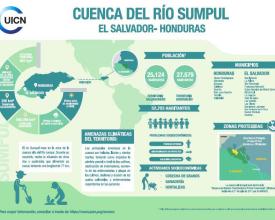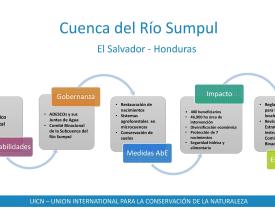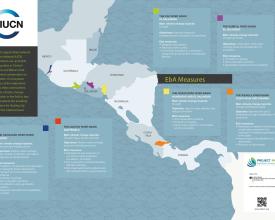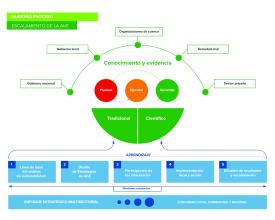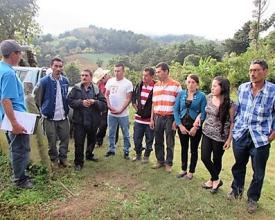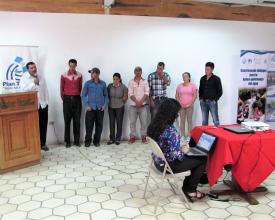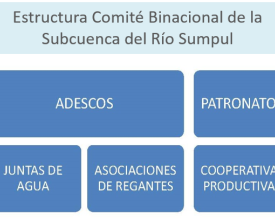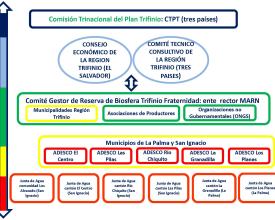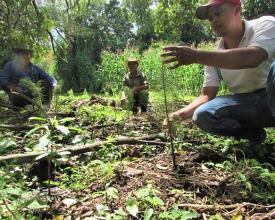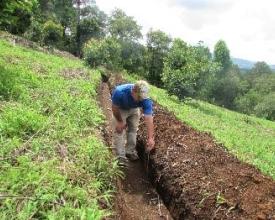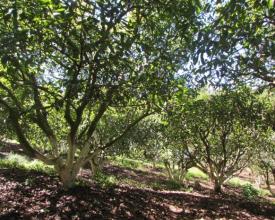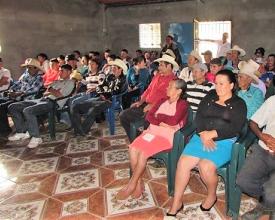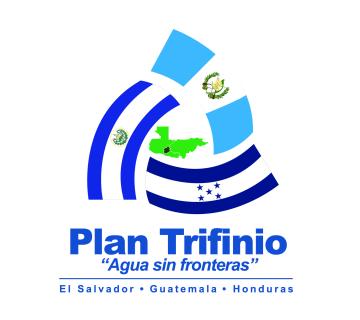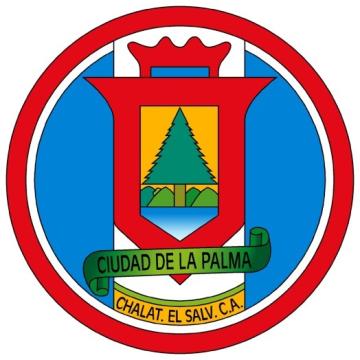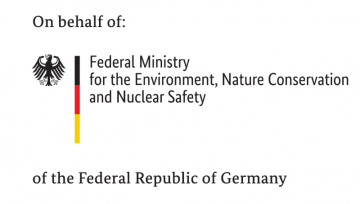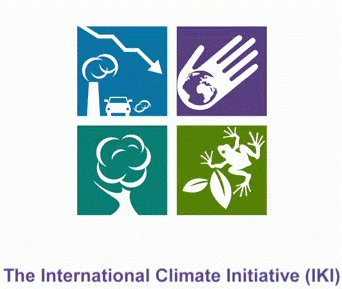
Strengthening multilevel governance for EbA in the Binational Sumpul River sub-basin (El Salvador-Honduras)

Water scarcity and water use rights have led to conflicts in the headwaters of Sumpul River sub-basin (867 km2), shared between Honduras and El Salvador. The climate change context makes the search for integral solutions that generate peace, transboundary development and resilience, crucial. Promoting a multidimensional (multilevel and multisectoral), participatory and flexible governance model, with an ecosystem approach, for adaptation is therefore an important step. In seeking the sustainable use of water as an adaptation need in Sumpul, existing governance structures were reinforced, boosting their representation, knowledge and management capacity. A common agenda was built based on greater dialogue and trust between stakeholders of the upper sub-basin facilitated by the Binational Community Committee. The agenda included the implementation of agroforestry systems and soil conservation practices to ensure water ecosystem services.
Context
Challenges addressed
- The sub-basin faces environmental degradation due to deforestation and contamination of soil and water from agriculture.
- The basin’s binational nature implies collaboration and coordination challenges between Honduras and El Salvador. Only on the Honduran side is there a specific legal framework for the integrated water resources management and watershed governance
- There are historical conflicts over the use of water, at the community or local level mainly but with binational interest.
- The main climatic threats are: strong variations in rainfall patterns, extreme temperature fluctuations ("frosts") and strong winds; landslides, floods and recurrent droughts also occur. These all cause damages to infrastructure, food production and local livelihoods, and contribute to aggravate poverty and the migration of people.
- There is little articulation between water resource management and scarce knowledge of decision makers and local leaders about ecosystem-based adaptation for water security.
Location
Process
Summary of the process
Governance for adaptation refers to the norms, institutions and processes that determine how power is exercised, responsibilities are distributed and decisions are made to address climate change. This solution advocates a governance for adaptation model that is multidimensional (BB1), participatory (BB2) flexible (BB3) and based on an ecosystem approach.
To strengthen adaptive governance in the upper Sumpul River, community governance structures were supported, in particular the Water Committees and the Binational Community Committee of the upper sub-basin (BB1).
Creating capacities, promoting leadership and establishing consensus within water management structures is the base for sustainable results in the future (BB2). Capacities need to be practical and involve multidimensional approach and deliver short term results. With capacities, organizations are able to develop management and policy instruments, nourished by scientific studies and local knowledge (BB3).
Building Blocks
Multidimensional governance for adaptation of water resources
Multilevel and multisectorial governance for adaptation implies working at multiple levels and with differente sectors. It requires creating connections for better articulation between territorial actors.
In the upper part of the Sumpul River sub-basin, this entailed working closely with grassroots (community-based) organizations to develop bottom up water resource management. This was done supporting the conformation of Water Committees linked with Community Development Associations (ADESCOs), the Municipalities and the Binational Community Committee.
The capacities of 4 Water Committees and their supply systems were strengthened and were thereafter formalized under municipal governance.
Moreover, and following the multilevel governance approach, the Binational Community Committe was strengthened throught restructuring advice, trainings, new management tools, and greater links with municipal governments. This Committee is now leading community water issues to prevent conflicts around water use.
Enabling factors
- Honduras legal framework (General Water Law) that defines different water basin governance structures; and in El Salvador the regulation of the ADESCO Water Committees, with a public health mandate.
- The existence of the Binational Committee was key, since work did not start from scratch, but rather focused on their strengthening and restructuring, respectively.
- The articulation of project and organization efforts across a territory is fundamental (e.g. between IUCN and Plan Trifinio)
Lesson learned
- The strengthening of existing local and community structures is vital, as these have the ability to sustain the progress and changes achieved in the territory, despite the alternation of local authorities.
- The ADESCOs and the Binational Community Committee undertake important mediation tasks, since the management of water resources can generate conflicts due to the diversity of interests that converge on this issue.
- The articulation of project efforts across a territory is fundamental (e.g. between the AVE and BRIDGE projects) to achieve greater impacts and efficiencies, through coordinated project agendas.
- The BRIDGE project in the Goascorán River basin (El Salvador-Honduras) left the following lesson learnt that is also relevant in this case: "Water diplomacy does not necessarily follow a straight path. Effective strategies need to incorporate multiple dimensions and a phased approach, interconnecting existing and emerging structures in the basin."
Capacity building to ensure the ecosystem approach
To improve local governance in the Sumpul River, it was crucial to mainstream the ecosystem approach into land management, and train accordingly water local governance structures, local authorities, and farmers. Together they implement EbA measures to face drought and variability such as: soil conservation practices, protected spring water and implemented agroforestry systems.
Capacity building was delivered to:
- >100 farmers through a "learning by doing" approach to attain demonstrative results in the field. The EbA measures implemented focused on the ecosystem services of water and soil, on productive diversification and on mitigating the impacts of climate change and variability (winds and extreme rainfall) on crops and goods and improve water infiltration and availability in the area.
- Water Committes on organizational and management skills as well as on integral water management, in order to influence their understanding of the importance of water ecosystem services.
- Leader and farmer women were trained on communication skills.
- Municipal officers were part of a regional climate change adaptation training and exchange of experience with other 30 local governements of Mesoamerica.
Enabling factors
- Synergies with existing projects and local organizations such as Plan Trifinio were crutial.
Lesson learned
- Exchanges of experience contribute to training processes and to motivate participants to take part in water governance, and recognize the learning value of actions that are carried out.
- Ensuring the capacities of local organization is key to ensure the provision of water ecosystem services, and will always be a good investment.
Developing flexible governance frameworks for adaptation
Governance for adaptation requires flexible policy and legal frameworks. Therefore, the upper sub-basin’s governance platforms required management instruments that would enable those adaptation options and forms of governance that brought about the greatest socio-environmental benefits to be valued and institutionalized. The Internal Regulations of several ADESCO Water Committees and the sub-basin’s Binational Community Committee were drafted, with the latter also updating its Strategic Plan (five-year plan) and Annual Operating Plan.
The process took into account new dynamics and trends in the sub-basin, as well as the EbA approach. The formulation of municipal policies was also supported (Local Adaptation Plans for La Palma and San Ignacio, El Salvador). Given that adaptation to climate change is immersed in a series of uncertainties about future climate impacts and development trajectories, these frameworks and instruments must be constantly evolving, always taking into account lessons derived from field and governance experiences. In this way, adaptation to climate change can move forward under a flexible approach, and through iterative cycles, generate short-term strategies in view of long-term uncertainties.
Enabling factors
- The continuous presence and the rooting in the territory of Plan Trifinio is a powerful enabling factor that provides flexibility in decision making and also vertical scaling. This trinational entity works closely with communities and knows the territory well, yet also has political weight and leverage with authorities, as it is part of the Central American Integration System and is chaired by the Vice Presidents and Presidential Delegate of three countries (El Salvador, Guatemala and Honduras).
Lesson learned
- The Sumpul sub-basin has an Integral Management Plan, the implementation of which falls on all sub-basin stakeholders, and which could be revitalized based on the progress made with EbA and the strengthening of governance for adaptation. Flexible governance should contemplate the monitoring, evaluation and updating of this Integral Management Plan based on lessons of implementes projects.
- The new management instruments prepared by the sub-basin’s governance platforms should in future be evaluated to determine how effective they were as adaptation responses. Any adjustments that result from this analysis will be a sign of flexible governance.
Impacts
Impoved local water governance
- Re-launching and consolidation of the Binational Community Committee of the Sumpul River sub-basin
- Strengthening of 4 water committees that manage the water supply systems for human consumption.
- New planning and management instruments developed for the local governance platforms (Binational Committee and 4 Water Committees).
- Greater articulation among key actors around integrated water resource management in the sub-basin.
- Active participation of youth and women on Water Committees and other local entities.
Increased local knowledge and capacities
- Committee members were trained on transboundary cooperation; integrated water resource management; ecosystem-based adaptation (EbA); and policy frameworks and legislation for water and climate change.
- Greater communication and advocacy skills, after training 38 community leaders in negotiation, policy influencing and communication.
- Capacities for EbA implementation improved of >100 farmers
Beneficiaries
- >100 farmers, and their families with technical support for EbA actions
- 4 Water Committees with organizational skills
- Sumpul Binational Community Committee and municipalities of La Palma and San Ignacio (SV) and Sinuapa (HN) involved in training
Sustainable Development Goals
Story
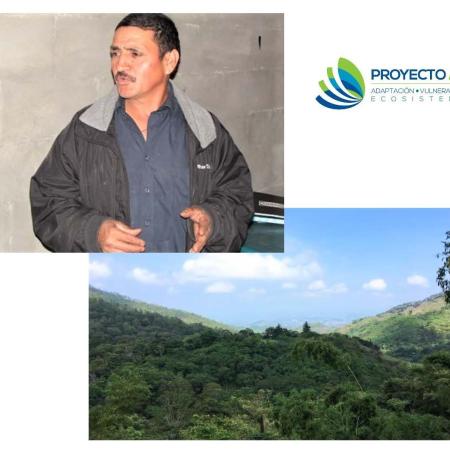
Mr. Teodoro Romero V., ADESCO President and member of the Water Committee and the Binational Committee of the upper Sumpul River basin: "Originally, [Los Alvarados] was a hamlet without water, despite having the Sumpul River as a source, which the community from Honduras had been using for 50 years. After deciding to gather water from this river, we began having problems, conflicts, discussions ... "
Rather than a conflictive element, water must be an integrating element, since it allows communities to communicate and unite with each other, to achieve fair and solidary access. Seeing the threats that climate change represents, agreements can be reached by adopting a communal vision and a dialogical attitude to conflict resolution. In this way, the communities of San Francisco Sumpul (Honduras) and the hamlet of Los Alvarados (El Salvador) went from being confronted to understanding that both are responsible for respecting the right to water and, consequently, the integrity of people and ecosystems.
They have seen that more knowledge achieves better prevention, and that, for climate change adaptation, it is important to integrate other actors into this prevention process. In this sense, the construction of a social fabric that contributes to the process is essential, which is why Plan Trifinio and IUCN involved not only the leaders of both communities but also the Mayor's Office and other organizations, both governmental and non-governmental.
"One of the problems we had at the beginning," confesses Teodoro, "was the distrust or caution that people showed in attending the meetings. Fortunately, this was overcome once the need to participate in the meetings was accepted."
With time, the Los Alvarados ADESCO (Association of Community Development) and its Water Committee were born. "We tried to establish a participatory regulation in order to manage and use water efficiently and effectively".
"One of the first fruits" –he continues- "was to have provision of the vital liquid, since three years ago; an effort that we had ongoing for 12 years. Second, we are strengthening our organization and third, raising awareness in the community in order to set up a fund to maintain the system. Now we live in better conditions, having water and sanitation as core elements of the community development."

